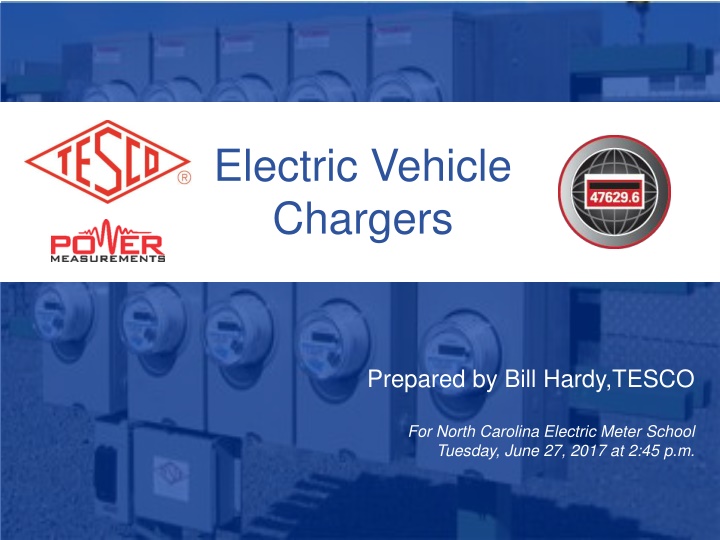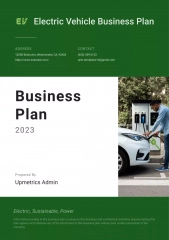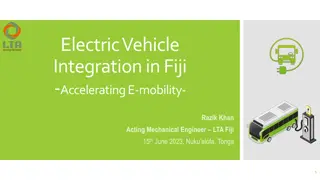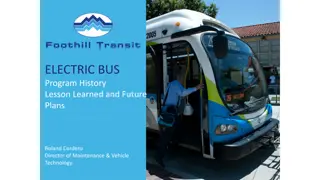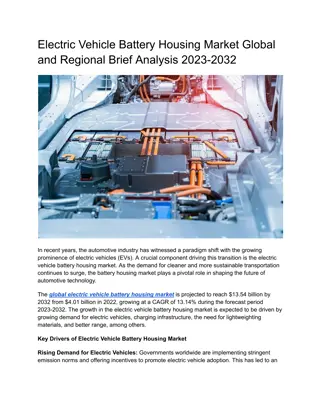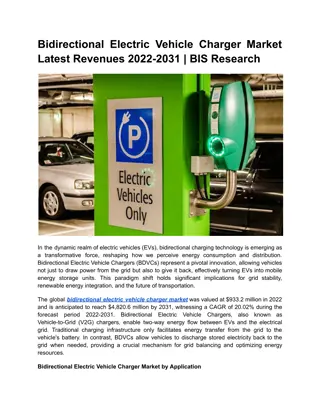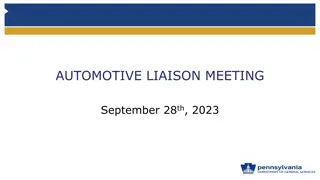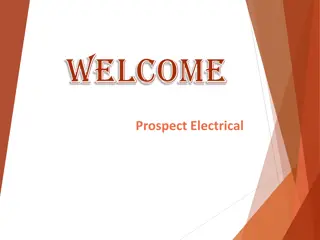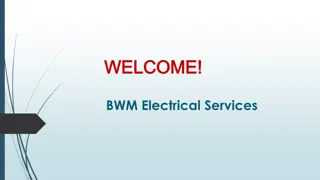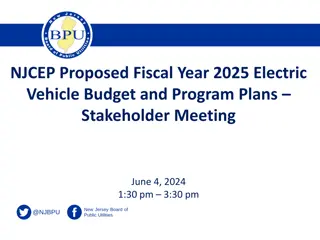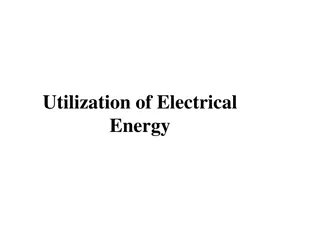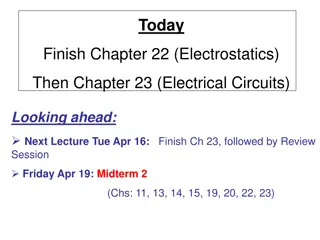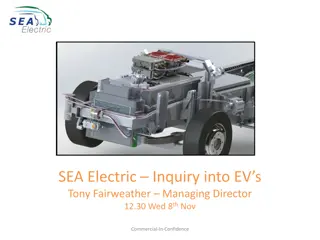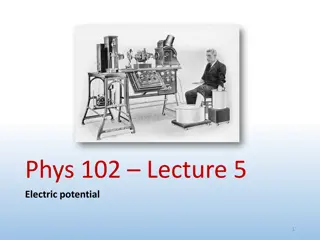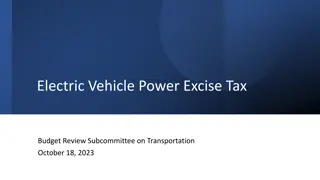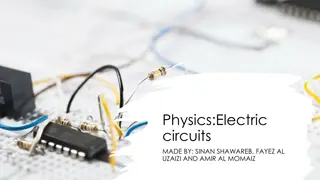Electric Vehicle Chargers.
Explore the world of electric vehicle chargers, EVSE market trends, and the increasing popularity of electric vehicles. Learn about the growth in charging infrastructure, market statistics, major auto manufacturers' plans for introducing electric vehicles, and strategies to address range anxiety and cost concerns. Stay informed about the evolving landscape of electric transportation.
Download Presentation

Please find below an Image/Link to download the presentation.
The content on the website is provided AS IS for your information and personal use only. It may not be sold, licensed, or shared on other websites without obtaining consent from the author.If you encounter any issues during the download, it is possible that the publisher has removed the file from their server.
You are allowed to download the files provided on this website for personal or commercial use, subject to the condition that they are used lawfully. All files are the property of their respective owners.
The content on the website is provided AS IS for your information and personal use only. It may not be sold, licensed, or shared on other websites without obtaining consent from the author.
E N D
Presentation Transcript
Electric Vehicle Chargers Prepared by Bill Hardy,TESCO For North Carolina Electric Meter School Tuesday, June 27, 2017 at 2:45 p.m.
Electric Vehicle Service Equipment What is it all about? Slide 2
INTRODUCTION EVSE Basics HB 44 Requirements Real World Testing Slide 3
INTRODUCTION Basic Statistics 30,221 Commercial Charging Spots 371 Non-Tesla DC Rapid Charge Locations 4,359 Tesla SuperChargers at 705 Locations >500,000 pluggable electric vehicles in US Slide 4
The EVSE MarketT 2015 - 15 Electric Vehicles on USGOV List ONE HAS 100+ MILE RANGE, most < 50 ALL have AC Level 1 and 2 Capability maximum Charging Rate is 7.2 kW, many only 3.6kW Three Offer DC Rapid Charge 2018 24 Announced ALL ELECTRIC VEHICLES All have 120+ mile range All have DC Rapid Charge (Most are J1772 Compatible) INFRASTRUCTURE IS ESSENTIAL TO MAKE THESE CARS SELL Slide 5
The EVSE MarketT Over 300,000 Tesla Model X reserved at $1,000 each in first three months. EVERY major auto manufacturer has multiple models on 2018 introduction plans. Slide 6
The EVSE MarketT July 21, 2016 Slide 7
The EVSE MarketT Slide 8
The EVSE MarketT 15,000 Slide 9
The EVSE Market Slide 10
The EVSE MarketT UNIVERSAL DRIVERS Auto Companies believe there are two major issues holding back electric vehicles Range Anxiety Cost to purchase compared to gas vehicles Range Anxiety is resolved in several ways Car has larger battery to extend range Charging gets below 15 minutes per hundred miles Wide spread availability of rapid charging stations Slide 11
THE MARKET UNIVERSAL DRIVERS Vehicle purchase cost Major part of vehicle cost is battery Battery costs are dropping very rapidly even as the battery capacity grows Efforts like the Giga-Factory and Chinese efforts promise to drive the price down further Giga-Factories just announced in Germany and Asia Examples: o Nissan Leaf was over $40K now under $30k o TESLA Model 3 is $35,000 Slide 12
THE MARKET Electric Vehicle Adoption Cheap Gas ?? Gas prices are very low now, but that has not slowed EV manufacturers plans for new model introductions Even at these prices EV fuel is 25% the cost of gas Certain urban areas may force wide scale adoption The probability that gas stays cheap forever is low Maintenance Costs Electric vehicles have almost no maintenance costs Lifetime ownership costs will be very low Slide 13
THE MARKET Electric Vehicle Adoption EV Economics overtake gas as lowest total cost to own and operate Maintenance Costs Electric vehicles have almost no maintenance costs Lifetime ownership costs will be very low Slide 14
THE EVSE MARKET Vehicles Must Charge Quickly for Wide Scale Adoption Typical miles per kWHr is 2.7 to 3.3 That is not likely to change much with technology improvements For a 100 mile range you need 30 kWHr of charge A Tesla SuperCharger delivers 120 kW and can add 170 miles of range in 30 minutes. Slide 15
THE EVSE MARKET Charge Times (hours) Battery kWHr AC Level 1 & 2 DC Fast Charge 1.92 3.65 7.29 14.58 21.88 29.17 32.81 36.46 40.10 43.75 7.2 0.97 1.94 3.89 5.83 7.78 8.75 9.72 10.69 11.67 19.2 0.36 0.73 1.46 2.19 2.92 3.28 3.65 4.01 4.38 50 0.14 0.28 0.56 0.84 1.12 1.26 1.40 1.54 1.68 120 0.06 0.12 0.23 0.35 0.47 0.53 0.58 0.64 0.70 200 0.04 0.07 0.14 0.21 0.28 0.32 0.35 0.39 0.42 400 0.02 0.04 0.07 0.11 0.14 0.16 0.18 0.19 0.21 10 20 40 60 80 90 100 110 120 Estimate based on 20% to 90% charge PHEV EV80 EV100+ Happy Spot Slide 16
THE EVSE MARKET Fill the Tank Costs COST TO FILLUP Price per kWHr Energy (kWHr) 10 1.00 1.50 2.00 3.00 4.00 5.00 20 2.00 3.00 4.00 6.00 8.00 10.00 40 4.00 6.00 8.00 12.00 16.00 20.00 Commercial Charging Station 80 8.00 12.00 16.00 24.00 32.00 40.00 100 10.00 15.00 20.00 30.00 40.00 50.00 120 12.00 18.00 24.00 36.00 48.00 60.00 0.10 0.15 0.20 0.30 0.40 0.50 Charge at Home Slide 17
MULTIPLE STANDARDS IN USE J1772 AC Level 1 Primarily for home installation 120 Volts at up to 16 Amps Maximum Power Delivery ( 1.92 kW ) Typical time to charge Pluggable Hybrid ( 3 5 hours, 0% to 100%) EV 80 Mile Range (8 20 hours, 20% to 100%) EV200 Mile Range ( 15 40 hours, 20% to 100%) 5.6 miles per hour of charge Slide 18
MULTIPLE STANDARDS IN USE J1772 AC Level 1 Public Stations Slide 19
MULTIPLE STANDARDS IN USE J1772 AC Level 2 Home and Commercial Installation 240 Volts at up to 80 Amps (30A and 50A most common) Home 30A, Commercial 30A, 50A, 75A Maximum Power Delivery ( 19.2 kW ) Typical time to charge Pluggable Hybrid ( 0.5 1.5 hours, 0% to 100%) EV 80 Mile Range (1.5 4 hours, 20% to 100%) EV200 Mile Range ( 3.2 10 hours, 20% to 100%) Slide 20
MULTIPLE STANDARDS IN USE J1772 AC Level 2 240V at up to 80A (19.2 kW) ( 56 miles per hour of charge) Most common is 32A (7.68 kW) ( 23 miles per hour of charge) Over 95% of commercial EVSEs are AC Level 2 All current EV/PEV in US can use this type though some need adapters Stations cost $3,000 - $8,000 Slide 21
MULTIPLE STANDARDS IN USE J1772 AC Level 2 - Public Stations Slide 22
MULTIPLE STANDARDS IN USE J1772 DC Rapid Charge Commercial Installation 200 to 600 Volts at up to 400 Amps (30A and 50A most common today) Commercial 50kW, 100kW Maximum Power Delivery ( 240 kW theoretical) Typical time to charge EV 80 Mile Range (0.3 1.5 hours, 10% to 80%) EV200 Mile Range ( 0.3 1.5 hours, 10% to 80%) At 50kW you get 150 miles per hour of charge Slide 23
MULTIPLE STANDARDS IN USE J1772 2016 for DC Level 2 Uses Duo Connector Only one connector for AC or DC Very few presently installed in US Will be standard for US and European manufacturers beginning in 2018 model year. Slide 24
MULTIPLE STANDARDS IN USE J1772- 2016 DC Level 2 Being installed at a rate of about 1 per every 100 AC Level 2 Driving factor Few current vehicles can use DC Fast Charge Mainly Tesla and Nissan Leaf These have their own free networks OVER 24 2018 models will have rapid charge capability Negative Stations cost $80,000 to $120,000 Slide 25
MULTIPLE STANDARDS IN USE J1772 DC Level 2 Slide 26
EVSE BASICS CHAdeMO Originated in Japan but used World Wide First DC Rapid Charging Standard Cars which use this for DC need separate J1772 connector for AC Most US stations at Nissan dealerships Not clear if Japanese manufacturers will switch to new SAE J1772 DUO standard Slide 27
EVSE BASICS CHAdeMO Slide 28
EVSE BASICS Tesla Largest US DC Fast Charge Network Exclusive to Tesla Owners Today it is free, but will not be for Model 3 buyers Will it fall under W&M regulations??? Protocol and hardware are proprietary Poses challenge for test equipment vendors Slide 29
EVSE BASICS Tesla Slide 30
MAJOR CHARGING NETWORKS Aerovironment (AV) BLINK ChargePoint The Electric Circuit EVGO GE Wattstations GreenLots SEMAConnect Tesla Slide 31
REGULATORY BACKGROUND U.S. National Work Group - Electric Vehicle Fueling and Submetering Formed two years ago to develop HB44 standards for EVSE and submetering applications Phase 1: EVSE Standard Initial work completed July 2015 New Provisional Standard Approved in July 2015 Effective Jan 1, 2016 HB44 Section 1.10 General Code Several changes relevant to EVSE HB44 Section 3.4 Electric Vehicle Fueling Systems Tentative Code HB44 Section 5.5 Timing Devices Several changes relevant to EVSE Slide 32
REGULATORY BACKGROUND Additional New Standards in Process NIST Handbook 130 Examination Procedure for Retail Electric Vehicle Fueling Systems This procedure is currently in development A draft version is available from Juana Williams at NIST NTEP PB14 Working Group Establishing type test checklist TESCO wins contract to build Primary Reference Standards and Type Test System for US NTEP Lab. Slide 33
HB44 APPLICABILITY A.1. devices, accessories, and systems used for the measurement of electricity dispensed in vehicle fuel applications wherein a quantity determination or statement of measure is used wholly or partially as a basis for sale or upon which a charge for service is based. General. This code applies to Slide 34
HB44 APPLICABILITY Exceptions-This code does not apply to: The use of any measure or measuring device owned, maintained, and used by a public utility or municipality only in connection with measuring electricity subject to the authority having jurisdiction such as the Public Utilities Commission. Electric Vehicle Supply Equipmentused solely for dispensing electrical energy in connection with operations in which the amount dispensed does not affect customer charges or compensation. The wholesale delivery of electricity. Slide 35
HB44 APPLICABILITY Use Cases NOT COVERED A store provides a free EVSE in its parking lot A paid parking lot provides EVSEs for which there is no charge based on the amount of energy delivered Tesla provides free charging services for owners An organization charges a monthly fee for unlimited use of its network of EVSEs. Slide 36
HB44 APPLICABILITY Use Cases COVERED ANY transaction which is based on the amount of energy delivered Examples An network of charge stations charges a monthly fee to belong AND a fee based on the amount of energy used A EVSE charges for the amount of energy delivered A parking lot charges for parking and EVSEs located in it also charge for the amount of energy delivered if used Slide 37
HB44 - REQUIREMENTS S.1.1. Electric Vehicle Supply Equipment (EVSE). An EVSE used to charge electric vehicles shall be of the computing type and shall indicate the electrical energy, the unit price, and the total price of each transaction. EVSEs capable of applying multiple unit prices over the course of a single transaction shall also be capable of indicating the start and stop time, the total quantity of energy delivered, the unit price, and the total price for the quantity of energy delivered during each discrete phase corresponding to one of the multiple unit prices. Slide 38
HB44 - REQUIREMENTS EVSEs capable of applying additional fees for time- based and other services shall also be capable of indicating the total time measured; the unit price(s) for the additional time based service(s); the total computed price(s) for the time measured; and the total transaction price, including the total price for the energy and all additional fees. Slide 39
HB44 TESTING TOLERANCES TEST TOLERANCES No Load Test. An EVSE measuring system shall not register when no load is applied. Starting Load. An EVSE measuring system shall register starting load test at a 0.5 ampere (A) load. Slide 54
HB44 TESTING TOLERANCES TYPE EVALUATION For type evaluation examinations, the acceptance tolerance values shall apply under the following conditions: at any temperature, voltage, load, and power factor within the operating range of the EVSE, and regardless of the influence factors in effect at the time of the conduct of the examination, and for all quantities greater than the minimum measured quantity. Slide 55
EPO 30 FIELD TEST Process in EARLY stage of development 1. Verify EVSE labeling meets requirements 2. Record all site information 3. Power on test equipment with load connected 4. Start test process on test equipment 5. Connect EVSE to test equipment 6. Determine maximum deliverable current (MDA) from CP signal 7. Set load to <=10% of MDA and perform the light load test Slide 56
EPO 30 FIELD TEST Process in EARLY stage of development 8. Perform the light load test (a) This requires doing a charging cycle and at the conclusion of energy delivery comparing the total energy and price registered on the EVSE with that measured by the test equipment. 9. Record the test results (a) Repeat 8 & 9 multiple times for reproducibility test 10. Set load to >85% of MDA and perform the full load test (a) This requires doing a charging cycle and at the conclusion of energy delivery comparing the total energy and price registered on the EVSE with that measured by the test equipment. 11. Record the test results Repeat 10 & 11 multiple times for reproducibility test (a) Slide 57
EPO 30 FIELD TEST Process in EARLY stage of development 12.Verify that after the final test that the display on the EVSE remains visible for at least 15 seconds 13.No Load Test (optional) Test system must initiate a valid charging sequence without placing a load on the EVSE. No energy should be registered. (a) (b) Not yet defined what No means or for how long the test should be performed Slide 58
EPO 30 FIELD TEST Process in EARLY stage of development 14.Starting Load Test (optional) Test system must initiate a valid charging sequence with a load of 0.5 amps. (a) (b) Energy must be registered, not clear at this point what the accuracy requirement is, if any if 0.5 amps is less than 10% of MDA. Slide 59
EPO 30 FIELD TEST Process in EARLY stage of development 15.Time Test (tbd) 16.RFI/EMI Test (tbd) 17.Zero-Setback Test On equipment activated with a single remote controller, activate one EVFS and check all others operated by the same controller to make certain they will not operate without activating the individual EVFS starting mechanism. a) Slide 60
OUR TEST SOLUTIONS T100 AC Level 1 & 2 to 32 Amps T200 AC Level 1 & 2 to 75Amps T400 AC Level 1 & 2 to 75 Amps DC Level 2 to 75 Amps Slide 62
OUR TEST SOLUTIONS PL400 PL100 AC Level 1 & 2 to 32 Amps PL200 200 AC Level 1 & 2 to 64 Amps AC Level 1 & 2 to 64 Amps DC Level 2 to 32 Amps Slide 63
OUR TEST SOLUTIONS TXXX EVSE TESTER Database driven Select a site and test Download all of your site data from your PC Locate site by GPS , ID or any other field Slide 64
OUR SOLUTION TXXX EVSE TESTER Automated Operation Create Test sequences which completely automate process Testing is then a simple one click process Slide 65
